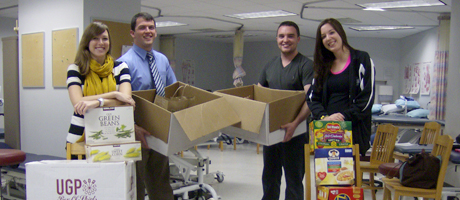By Jennifer Eder
When 94 students from the George Washington Doctor of Physical Therapy Program set a goal of performing 1,000 hours of community service this fall, they worried about where they might find the time in their busy schedules.
The students are in class from 9 a.m. to 5 p.m. Monday through Friday, and outside the classroom, they spend hours studying in small groups and practicing therapy techniques on one another and simulated patients.
But the doctoral students not only met their goal, they exceeded it by more than 200 hours.
“We thought it was a pretty ambitious goal, but we really wanted to make it a challenge,” said Josh D’Angelo, a second-year doctoral physical therapy student. “At first it was tough to encourage students to do service on top of class and all the studying that we have to do, but as soon as we got started, it became contagious. And it was really exciting to watch us meet the challenge.”
Students volunteered at a pro bono physical therapy clinic in Northeast near Catholic University, several races around the Washington area, numerous health fairs and with a project that rates parks throughout the District on their accessibility for children.
The service initiative was started as a way for students to give back to the community and to receive hands-on experience with patients.
“It’s very easy to get into a rut as a student, going to class and going home and studying,” said Rob Rogacki, another second-year physical therapy student from Lansing, Mich. “But doing service reenergizes us.”
While the goal of 1,000 hours in a semester is new to GW’s physical therapy program, the commitment to service is not. Six years ago, two alumni from the program started the Little Workers of Sacred Heart pro bono physical therapy clinic, which treats underinsured or uninsured patients. Licensed physical therapists and a handful of students from GW’s physical therapy program volunteer at the clinic every Saturday. Usually students can only volunteer once or twice a semester because the interest was so high.
“It’s extremely rewarding to have that patient interaction and make that connection,” said Mr. D’Angelo, of Ann Arbor, Mich. and president of the Class of 2013. “You remember why you are going through this intensive program, and it helps us practice and become better clinicians in the end.”
Mr. D’Angelo decided he wanted to become a physical therapist after having to go through physical therapy himself following a back injury after high school that left him unable to walk, drive or even sit without significant pain.
“I went to therapy, and it completely enabled me to do all of the activities I loved once again. I was like, ‘Wow, this is incredible, and I would love to be able to provide this to others,’” Mr. D’Angelo said. “I really saw the potential that PT had.”
What makes physical therapists unique among health care professionals is the amount of time therapists get to interact with patients. Most physical therapy appointments are between 30 to 60 minutes.
“We really have an opportunity to get to know our patients and how they’re functioning in their daily lives,” said Mr. D’Angelo. “We can build really strong relationships and trust with our patients and influence what they’re doing on a daily basis.”
During GW’s three-year program, which is housed in the School of Medicine and Health Sciences and graduated its 10th class last spring, students spend the first two years in the classroom with several clinical immersions, while the third year is solely clinicals. Each class is only around 34 students, which makes the program like a family, Mr. Rogacki said.
“Between our classes and studying together, we spend an enormous amount of time together. It builds a lot of camaraderie,” said Mr. Rogacki, a service chair for the Class of 2013.
This fall, the students began working with the Parks for Pediatric Prescription Project, a park-rating project that will eventually enable pediatricians to “prescribe” outdoor activity for rehabilitation or just for general exercise. The project was started by Robert Zarr, president of the D.C. chapter of the American Academy of Pediatrics and an assistant clinical professor at GW. Parks are rated on things like lighting, handicap access, number of water fountains, play space and whether they allow dogs. Next semester, the students will help Dr. Zarr create a database of the park ratings.
“The faculty was really impressed that the students made an active effort to participate in the greater D.C. community. They didn’t get funneled into the ‘I have to be a student, and I’m here just to learn,’” said Alison DeLeo, an assistant professor in the physical therapy program and the faculty liaison to students. “The service makes them so well-rounded. They learn how to feel comfortable walking into various settings and communicating with people from all different backgrounds.”
In addition to the pro bono clinic and the park-rating project, students volunteered at the Marine Corps Marathon, the Nation’s Triathlon and various health fairs around the city. They’re hoping to expand the service initiative throughout the School of Medicine and Health Sciences next year.
“People have seen how much they can learn through service, how it’s really worth it and how much of a difference you can make in someone’s life,” said Mr. D’Angelo. “If you build a habit of service now, you’re more likely to do it in the future.”


